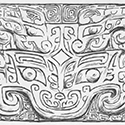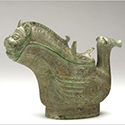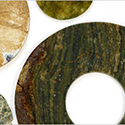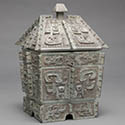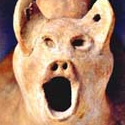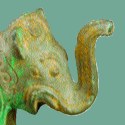|
|
| Show All 49 Results (Text Only) |
|
| Ancient China: From the Neolithic Period to the Han Dynasty [PDF] |
|
| Asian Art Museum of San Francisco
|
"An historical overview of ancient China—from the Neolithic period (approx. 6,000–2000 BCE) to the end of the Han dynasty (220 CE)" This packet explores the rise of ancient Chinese civilization and how belief systems and cultural values are reflected in surviving examples of its material culture. The packet features important archaeological excavations such as the Tomb of Fu Hao, created in the Shang dynasty (approx. 1600–1050 BCE); the Tomb of Marquis Yi of Zeng, created in the Warring States period (approx. 480–221 BCE); and the Terracotta Army of Qin Shi Huangdi, the First Emperor of the Qin Dynasty (221-206 BCE), created approx. 210 BCE. Other highlights include Chinese jades, bronzes, and ceramics in the Asian Art Museum’s collection galleries. The packet includes interactive activities for the classroom and student handouts. See also content and multiple downloads on An Introduction to the Qin Empire (221–206 BCE), An Introduction to the Han Dynasty, and An Introduction to the Shang Dynasty.
Go to Museum Resource: https://education.asianart.org/wp-content/uploads/sites/6/2019/09/Ancient-China... | |
|
|
| Ancient Chinese Bronzes - Lesson Plan |
|
| National Museum of Asian Art, Smithsonian Institution
|
Chinese civilization made great advances as it emerged from the Neolithic period and entered the Bronze Age. One factor in this change was the ability to locate and extract natural deposits of copper and tin for making bronze. Foundries capable of heating the ores to high enough temperatures for mixing and casting metal were established in northern areas of China around 1700 BCE. One of the largest and most impressive early foundries was at Anyang, the capital of the late Shang dynasty from about 1300 to 1050 BCE. For more on the bronzes at the Smithsonian and how they were cast, see also Ancient Chinese Bronzes.
Go to Museum Resource: https://asia.si.edu/learn/ancient-chinese-bronzes/ | |
|
|
| Ancient Chinese Jades |
|
| National Museum of Asian Art, Smithsonian Institution
|
Poetically described two thousand years ago in China as the "fairest of stones," jade actually refers to two different minerals, nephrite and jadeite. All of the true jades found at ancient Chinese sites are made of fine-grained nephrite. In its purest state nephrite lacks color; impurities create the variations of yellow, green, brown, and black. See also Jades for Life and Death.
Go to Museum Resource: https://asia.si.edu/learn/ancient-chinese-jades/ | |
|
|
| Ancient Chinese Ritual Bronzes |
|
| Harvard Art Museums
|
Excellent short presentation of 8 slides, with commentary, including a diagram of piece-mold casting and an enlarged image of a taotie or mask-like face from a bronze urn. Part of the museum’s “Hotspots” digital images.
Go to Museum Resource: https://www.harvardartmuseums.org/tour/hotspots/stop/241 | |
|
|
| Ancient Tombs |
|
| University of Washington, Visual Sourcebook of Chinese Civilization
|
"This unit contains summaries of five archaeological sites, ranging in date from about 2300 BC to 100 BC. The tombs selected for examination were all advanced for their time. Their occupants were members of the ruling class of the period, able to afford the highest standard of material comfort, technical excellence, and artistic embellishment then available." A Visual Sourcebook of Chinese Civilization was prepared by University of Washington history professor Patricia Buckley Ebrey. With questions for discussion, timelines, maps, and suggested readings. Select HOME to find link to teachers' guides for all topics featured on the website.
Go to Museum Resource: http://depts.washington.edu/chinaciv/archae/2tommain.htm | |
|
|
| Architectural Models (Eastern Han Dynasty) |
|
| Minneapolis Institute of Arts
|
"Tall pottery towers and other architectural models were popular during the Eastern Han dynasty (A.D. 25-220). These, along with ceramic replicas of houses, human and animal figures, cooking implements, and bronze ceremonial vessels, were created to be placed inside the tomb to accompany the deceased into the afterlife." A short introduction to the models, with five related objects, all with descriptions, and an in-depth interview with an MIA curator.
Go to Museum Resource: http://archive.artsmia.org/art-of-asia/explore/explore-collection-architectural... | |
|
|
| The Art and Archeology of Ancient China: A Teacher's Guide [PDF] |
|
| National Museum of Asian Art, Smithsonian Institution
|
An illustrated 106-page teacher's guide that can be downloaded in .pdf format, in three parts. Go to middle of HTML page and select Part I, Part II, and Part III to download the guide. Includes historical background from China's Late Neolithic Period (BCE ca. 5000-2000) to the Han Dynasty (BCE 206-220 CE), plus a timeline, vocabulary list, pronunciation guide, four lesson plans, plus featured object studies on 1) Clothing and Personal Adornment (Silk and Jade); 2) Food Preparation and Utensils; 3) Transportation; 4) Ceremonies (Music); 5) Writing (Chinese Characters); 6) Industry (Bronze Casting); 7) Building. Also a special chapter on Ancestor Worship, then and today.
Go to Museum Resource: https://asia.si.edu/wp-content/uploads/2020/05/Art-and-Archaeology-of-Ancient-C... | |
|
|
| Bronze Age Casting |
|
| National Museum of Asian Art, Smithsonian Institution
|
|
The ability to make bronze tools, weapons, and ritual vessels was such a significant advancement in world civilization that it lends its name to an entire era: the Bronze Age. The skill and resources needed to fabricate bronze were in place in ancient China by 1700 BCE, over a thousand years later than in Egypt, Mesopotamia, and India. The earliest Chinese bronze artifacts have been traced to the Erlitou culture in Henan province. Their discovery confirms foundries for smelting and casting metal were active in northern China between 1300 and 900 BCE, a highpoint of early Chinese casting.
Making bronze requires two things: copper and tin ores, sometimes mixed with lead; and intense heat for refining and casting. Chinese founders made their metal objects using clay for both models and removable section molds. (This differs from the Mediterranean and European practice of casting objects using wax-covered models.)
Go to Museum Resource: https://asia.si.edu/learn/ancient-chinese-bronzes/bronze-age-casting/ | |
|
|
|
| Show All 49 Results (Text Only) |

